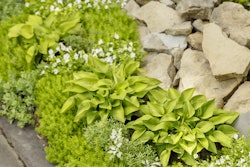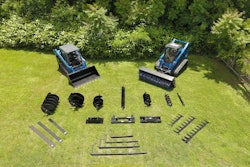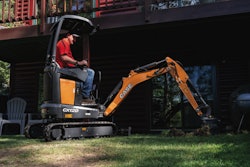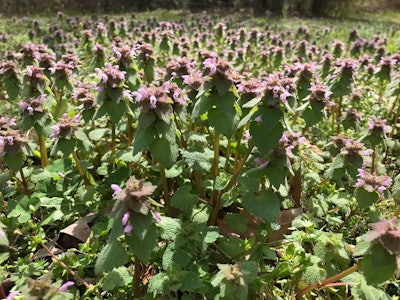 Purple deadnettle can be differentiated from henbit by the shape of its leaves, which are triangular, while henbit’s are scalloped.
Purple deadnettle can be differentiated from henbit by the shape of its leaves, which are triangular, while henbit’s are scalloped.Photo: Caleb Odom
With spring around the corner, customers may be looking for hints of color in the landscape. But they don't necessarily want to see any color (other than green) on their lawn. Unfortunately, swaths of purple from either henbit, purple deadnettle or both may be growing with exuberance if no steps are taken to control them. These weeds can be pesky in both the lawn and the landscape.
What’s the difference?
Both henbit and purple deadnettle are winter annual weeds that germinate in the fall or winter. Mild winters can result in both henbit and purple deadnettle getting a head start on turfgrass.
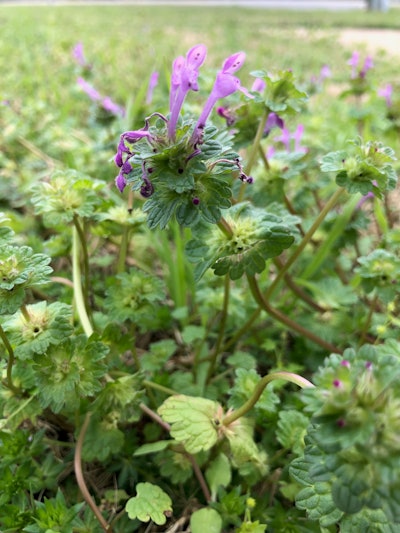 Henbit has more tubular purple flowers and no petioles on its upper leaves.
Henbit has more tubular purple flowers and no petioles on its upper leaves.Photo: Jill Odom
They grow and produce seeds in the early spring and will die off in the late spring and early summer as temperatures rise. They can be found growing in backyards, garden beds, and fallow fields.
These two weeds prefer moist, nutrient-rich soil and will invade any areas where turfgrass is bare. They thrive in cool, spring weather and rain. Shady spots can encourage growth as well.
Like many plants considered weeds, henbit and purple deadnettle are actually a food source for pollinators. These two weeds provide pollen and nectar for honeybees and bumblebees in March and April. The seeds are also eaten by many species of birds.
Both henbit (Lamium amplexicaule) and purple deadnettle (Lamium purpureum) are part of the mint family, which is part of the reason why the two are often mistaken for the other.
To make things more confusing, the two weeds are often found growing together. Here is the breakdown of what sets them apart from each other.
Henbit produces purple tubular flowers at the end of its stems in small whorls. Henbit’s flowers are pink to purple with darker purple spots. Its leaves are scalloped and rounded. The lower leaves have petioles, but their upper leaves do not.
Purple deadnettle likewise produces purple flowers, but its flowers are winder than henbit’s and are a lighter purple. The leaves of purple deadnettle are triangular with petioles and the leaves tend to have purple coloring, especially closer to the top of the plant. The leaves overlap each other and are also a little fuzzier than henbit leaves.
How to control them
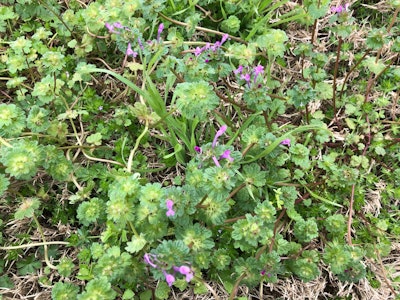 Henbit and purple deadnettle have a tendency to take over areas with sparse turfgrass.
Henbit and purple deadnettle have a tendency to take over areas with sparse turfgrass.Photo: Jill Odom
If your clients are having problems with either one or both of these weeds overrunning their yard, there are several different control methods to consider.
The first option is to focus on improving cultural practices. Maintaining a thick, healthy turf leaves very few bare spots for henbit or purple deadnettle to find a foothold.
Good turfgrass practices include properly fertilizing, mowing at the proper height, and irrigating. If your customer has bare patches in their lawn, it is best to consider seeding these areas in the fall.
If there aren’t many of one of these weeds present, they can be hand-pulled or hoed out. This is viable at the beginning of an infestation or when the weeds are young. A 3-inch layer of mulch in a garden bed can prevent germination and the few weeds that do appear here can be hand weeded.
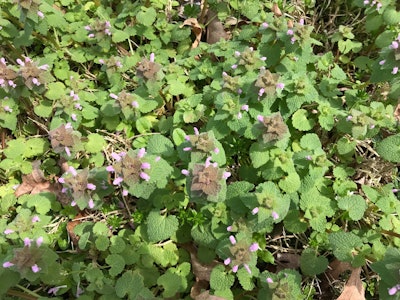 Control methods for both weeds works best in the fall before the seeds germinate.
Control methods for both weeds works best in the fall before the seeds germinate.Photo: Caleb Odom
As for chemical control methods, it depends on what season it is to know what chemicals should be applied.
When trying to prevent henbit or purple deadnettle from appearing in the first place, it is best to use a pre-emergent herbicide in the late summer/early fall before the seeds germinate.
If this window of opportunity is missed, a two-, three- or four-way post-emergence product should be applied with an active ingredient such as fluroxypyr, triclopyr or clopyralid. These applications are more effective when applied to immature, actively growing henbit or purple deadnettle in the fall.
For spring applications on mature weeds, more applications may be needed.

